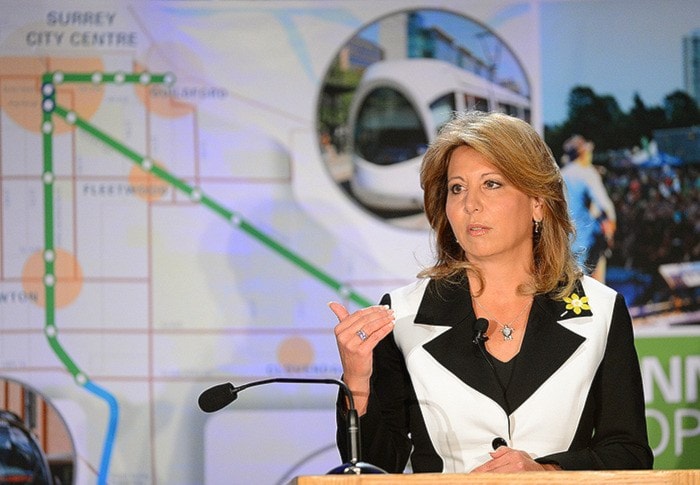More schools, effective transit and accessible health care were some of the highlights of the mayor's State of the City address delivered on Wednesday afternoon.
Surrey Mayor Dianne Watts spoke to a crowd of 500 at the Sheraton Vancouver Guildford Hotel, where she announced some initiatives to help with health care, transit and education.
Surrey will be partnering with the Surrey School District to created a "Campus of Learning-Active Living and Sport Excellence" in Grandview.
The plan is to create a new high school right next to where Surrey is building a recreation and aquatic centre at 24 Avenue and 168 Street.
Both the city and district own land there, and will be lobbying the provincial government for capital funding to build the school.
"This new model, we are pleased to say, can be replicated anywhere in the city," Watts told the crowd. "This campus includes an aquatic centre-new secondary school-community campus of support services and shared infrastructure."
The new high school would take pressure off the overcrowded Earl Marriott Secondary School at 16 Avenue and 157 Street.
She also said more capacity for post-secondary education must be a top priority for the provincial government.
"Almost a quarter of all B.C. students come from Surrey/South of the Fraser. In Surrey we have 13 spaces for every for every 100 students," Watts said. "That simply isn't good enough."
It means that local universities have to increase the academic requirements for students wanting to attend.
"Surrey high school students who graduate with a 75-per-cent average do not have access into our universities," she said. "Due to lack of funded spaces, the acceptance rate is 85 per cent."
Another challenge facing Surrey is the lack of accessible public transit, Watts said.
"Not having rapid transit infrastructure is a significant problem in shaping our growing city," Watts said. "We have less than six kilometres (of SkyTrain) for 500,000 people, and 70 per cent of the region's growth is coming South of the Fraser."
The answer to that problem will only come with legislative change to the TransLink form of governance, she said.
"The mayors and I – as chair of the Metro Vancouver Transportation Committee – are asking the government to change provincial legislation, so we can move this region forward, shape future growth and ensure we have a livable sustainable region."
Watts said exciting advances are taking shape in the area of health care for Surrey, including the new critical care tower being built at Surrey Memorial Hospital and the Jim Pattison outpatient care facility.
More can, and will, be done, she said.
Watts also announced the creation of "Innovation Boulevard," a high-tech research and development area spanning from Surrey Memorial Hospital (13750 96 Ave.) to SFU Surrey in City Centre.
The city is looking into bringing high-speed fibre optic data cables to the area to enrich the connectivity for companies locating along the boulevard.
"Access to ultra high-speed digital infrastructure is a key element for success," Watts said.
The rapid growth of Surrey is presenting both opportunities and challenges, she said.
"We are witnessing and participating in the building of a very unique city," Watts said. "And this journey is one that we will look back on with a smile and recognize were all part of something special."
